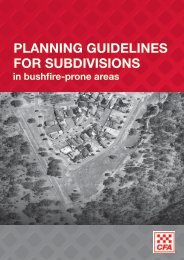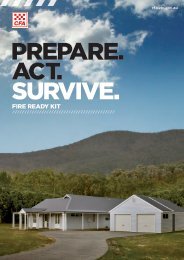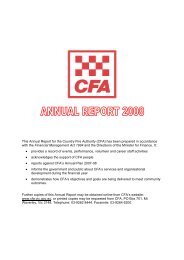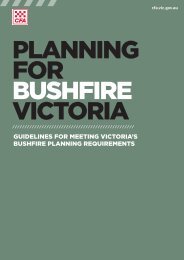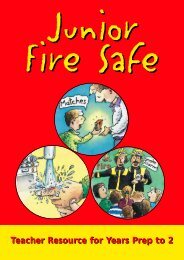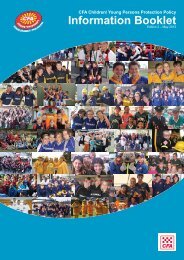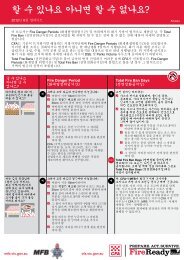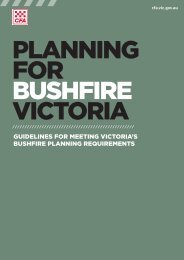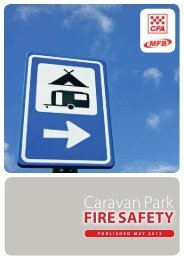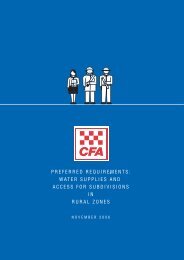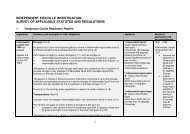Training Specifications and Guidelines - Country Fire Authority
Training Specifications and Guidelines - Country Fire Authority
Training Specifications and Guidelines - Country Fire Authority
Create successful ePaper yourself
Turn your PDF publications into a flip-book with our unique Google optimized e-Paper software.
Forest Industry Brigade<br />
<strong>Training</strong> Specification <strong>and</strong> <strong>Guidelines</strong><br />
Element<br />
informal meetings<br />
6. Prepare <strong>and</strong> process<br />
routine written<br />
correspondence notes<br />
<strong>and</strong> records<br />
Critical aspects of<br />
evidence<br />
Performance criteria<br />
2. Responses are sought from, <strong>and</strong> provided to, other group members in a<br />
constructive way<br />
3. Views <strong>and</strong> opinions of individuals or a group are understood, acknowledged<br />
<strong>and</strong> accurately represented to others where required<br />
1. Information <strong>and</strong> ideas are presented in a format, language <strong>and</strong> timeframe to<br />
meet organisation’s requirements<br />
2. Presentation of written documents meets organisation’s st<strong>and</strong>ards of style <strong>and</strong><br />
accuracy<br />
3. Documents are processed to comply with legislative requirements <strong>and</strong><br />
organisation’s policy <strong>and</strong> procedures<br />
It is essential for this unit that competence be demonstrated in<br />
effectively interacting with clients <strong>and</strong> communicate verbally<br />
<strong>and</strong> non verbally<br />
A qualified Plantation <strong>Fire</strong>fighter successfully completing CFA Crew Leader program will provide<br />
qualification for endorsement for the role of Plantation Crew Leader.<br />
INCIDENT CONTROLLER 1<br />
To qualify for endorsement as an Incident Controller Level 1, you need to be a qualified Plantation<br />
<strong>Fire</strong>fighter <strong>and</strong> assessed as competent in CFA Crew Leader.<br />
NB: All officers must, as a minimum, be qualified Crew Leaders <strong>and</strong> Incident Controller 1.<br />
The following information is a guide to what you need to know or be able to do/demonstrate <strong>and</strong> directs<br />
you to the learning materials you will need to access prior to skills recognition.<br />
PUAOPE001A<br />
Descriptor<br />
Supervise response<br />
This unit covers the competency to supervise a response by a small team to<br />
incidents <strong>and</strong> may include the use of aircraft, which are time critical <strong>and</strong>/or<br />
potentially threatening to life, property or the environment.<br />
The unit includes the competency to proceed to the incident, assess the incident,<br />
<strong>and</strong> plan <strong>and</strong> implement an operational response <strong>and</strong> post-response activities.<br />
Element<br />
1. Receive incident<br />
response request<br />
Performance criteria<br />
1. Requests for response are received <strong>and</strong> dealt with in accordance with<br />
organisational policy <strong>and</strong> guidelines<br />
2. Relevant incident information is obtained <strong>and</strong> assessed to enable personnel to<br />
make appropriate preparations<br />
3. An appropriate response is determined according to the type of incident <strong>and</strong><br />
information available in accordance with organisational policies <strong>and</strong><br />
procedures<br />
4. The location of the incident <strong>and</strong> the most appropriate route to the incident are<br />
ascertained<br />
2. Proceed to incident 1. Personnel, equipment <strong>and</strong> transport resources are dispatched promptly,<br />
consistent with the nature of the incident <strong>and</strong> the information available<br />
2. Communication is established <strong>and</strong> maintained<br />
3. An appropriate route to the incident is followed to minimise response time<br />
4. En-route hazards are recognised <strong>and</strong> negotiated to minimise risk<br />
5. Multi-vehicle response is conducted in accordance with the organisation’s<br />
procedures<br />
3. Assess the incident 1. Observations are made en route to assist with incident assessments<br />
2. Assigned personnel’s arrival at the incident is confirmed according to<br />
organisational policies <strong>and</strong> procedures<br />
3. Communication with on-site personnel is established<br />
4. An initial assessment of the incident is carried out promptly<br />
Edition 2,<br />
May 2008 Safety First Page 18



